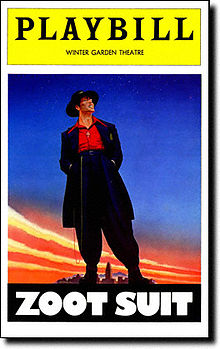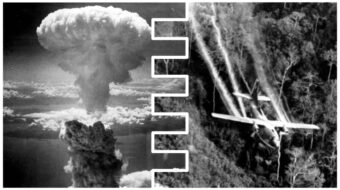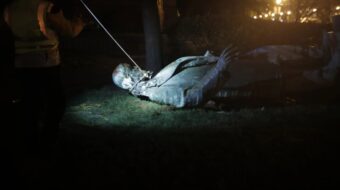
Over the course of five days, beginning on June 3, 1943, simmering racial unease exploded as hundreds of white sailors stationed in Los Angeles stormed into East L.A. and began beating Hispanics in response to an earlier downtown altercation between a few sailors and some street kids. The sailors commandeered a fleet of taxicabs and targeted Zoot Suiters – youths outfitted in the defiant, exaggerated costume of their community (long jackets, high-waisted, wide peg-legged trousers and ankle-length watch chains, plus “duck tail” hairdos), most of them Latino, but also some Blacks, Filipinos, and others. Gangs of sailors marched into movie theaters, bars, and pool halls, and beat up anyone they singled out, stripping them and urinating on – and in some cases burning – their clothes.
The rioting grew as police either stood by or arrested the victims. The media, antagonistic to the Hispanic community, fanned the violence with sensational headlines and racial slurs about a fictitious “Mexican crime wave.” “Zoot Suiters Learn Lesson in Fight with Servicemen,” declared the Los Angeles Times.
Mexican American men were already in military uniform, disproportionately so for their numbers. Yet this was not what bored, restless young white servicemen saw on the streets of L.A., nervous about their imminent future in Pacific combat.
After several days of unrest, military brass declared Los Angeles off-limits to its personnel. Within a week, the streets of L.A. were quiet again, but the official Navy position remained that their sailors were acting in “self-defense against the rowdy element.” In the aftermath, similar attacks took place in a number of other cities. Detroit experienced a major race riot only a few weeks later.
No deaths resulted, but more than 150 had been injured, and police had arrested and charged more than 500 Latino youths for “rioting” or “vagrancy.” A special state investigatory commission was convened, which held the victims blameless, although L.A. Mayor Fletcher Bowron still asserted that local Mexican youth gangs incited the riot. The L.A. City Council banned zoot suits. “The zoot suit has become a badge of hoodlumism,” said Councilman Norris Nelson. “We prohibit nudism by an ordinance and if we can arrest people for being underdressed, we can do so for being overdressed.”
In her newspaper column, First Lady Eleanor Roosevelt wrote that the riots were symptomatic of a problem with deep roots. “It is a racial protest. I have been worried for a long time about the Mexican racial situation…and we do not always face these problems as we should.” The Los Angeles Times answered with its June 18 headline, “Mrs. Roosevelt Blindly Stirs Race Discord.” The editorial page accused her of communist leanings.
The California Eagle, L.A.’s black weekly, edited by the progressive Charlotta Bass, defended the Latinos, urged solidarity among people of color, and blasted the mainstream press for “race baiting.”
The unspoken law of impunity ruled the day. No one was brought to justice over the Zoot Suit riots. The only ones to suffer any real consequence were the Latino victims injured and arrested.
This incident gave rise to a powerful 1979 drama by Luis Valdez called “Zoot Suit,” the first Chicano play on Broadway. In 1981 it became a movie.
Adapted from Chase’s Calendar of Events, Los Angeles Almanac, and other sources.
Photo: Wikimedia (CC)










